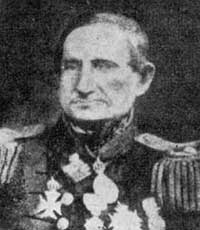|

Bartholomew Hayden (1792-1857),
navy officer in Brazil
|
Hayden, Bartholomew
(1792-1857), navy officer in Brazil, was born in County
Tipperary on 22 February 1792, the son of John and Joanna
Hayden. Like many young men of his age,
Hayden joined the armed forces of King George III of Great
Britain during the Napoleonic Wars and served in the Royal Navy
as a Midshipman for twelve years, from 1803 to 1815. Following
the British victory over Napoleon, the Royal Navy was
demobilised and reduced to a fraction of its former strength.
There were jobs available for just 15 per cent of its former
officers, but Hayden was one of the fortunate ones. In 1817, he
was appointed senior Midshipman to the frigate HMS Andromache
which was sent to South America as part of the squadron
defending British interests during the wars of independence from
Spain which were commencing in the Pacific.
In February
1821, Hayden moved to the HMS Conway, commanded by
Captain Basil Hall FRS, as Second Master (that is,, Assistant
Navigating Officer) when the two ships were in Peru. Hall was an
enterprising and scientifically minded officer who on his return
published a popular two-volume book detailing the
Conway's
activities in South America. Hayden never did return home.
Knowing that he lacked the necessary 'pull' to secure a further
appointment in the navy, he resigned and, with the help of
friends, purchased a brig called the Colonel Allen to
pursue a career as a trader. Fortuitously, when Admiral Lord
Thomas Cochrane, following his victories over the Spanish as
Vice Admiral of Chile, was looking for a ship to take him to
Brazil, Colonel Allen was the vessel he chose. The
Brazilian war of independence against Portugal was then reaching
a climax. The Prince Regent, Dom Pedro, had raised the standard
of revolt against Portugal and been proclaimed Emperor a year
earlier, but enemy garrisons still occupied half of the country,
and unless Brazil's newly formed navy could seize command of the
sea, chances of success looked bleak. The Brazilian Government
was desperately seeking ships and experienced officers and
Hayden offered his services. His ship was purchased, converted
into a man-of-war and renamed
Bahia,
while Hayden himself was appointed to the Brazilian Navy with
the rank of Commander (Capitão-Tenente).
In that capacity, Hayden served with Cochrane, by now
commander-in-chief of the Brazilian Navy, in his successful
campaign against Portugal. Hayden was present when the enemy
were driven from their principal base of Bahia in 1823 and back
to Portugal, and he was active in the suppression of the
dangerous republican rebellion in the north-east the following
year. In command of the brig
Pirajá
during
Brazil's two year war against Buenos Aires from 1826 to 1828,
Hayden captured
the Argentine privateer Libertad del Sur and was promoted
to Captain of Frigate as a consequence. Then, transferring to
the corvette Liberal in the inshore squadron blockading
Buenos Aires, he took part in the minor battles of Quilmes and
Monte Santiago, both of which inflicted serious damage on the
Argentine naval forces led by a fellow Irishman, Commodore
William Brown. With the termination of the War, Hayden was
posted to the corvette Animo Grande as commander of the
Brazilian Naval Division of the East, which was deployed off
Angola with orders to help suppress the slave trade.
In June 1829, Hayden married Anna da Fonseca Costa in Rio de
Janeiro, a marriage which produced five children. However the
achievement of external peace was balanced by a sequence of
internal rebellions within Brazil. In an optimistic moment
following independence, the power of the central government had
been deliberately weakened. Now, only the loyalty of the armed
forces kept the country united. As commander of the frigates
Imperatriz
and Campista, Hayden was prominent in the suppression of
the 'Cabanos' rebellion which afflicted Pará in 1835-1836. As a
reward, he was promoted to full Captain (Capitão-de-Mar-e-Guerra)
in October 1836. In 1839, Hayden was given leave of absence from
the navy to join a steam packet company as commander of the
paddle steamer Maranhão. He returned to the navy in 1840
in command of the training ship Campista. He formally
retired from service in 1842. The spat of regional rebellions
which had afflicted Brazil during the 1830s had, however,
convinced the young Emperor Pedro II that a strong central
government was needed and that an efficient and modern navy was
vital to Brazil's internal security. Hayden's technical
expertise was obviously valuable at a time when the Brazilian
navy was taking on the challenges of steam power and new
advances in weaponry. In 1849, he was therefore restored to the
Active List in the rank of Commodore (Chef-de-Divisão) and in
1851 became a member of the influential Naval Armaments
Commission. Now aged sixty-six, Hayden's health began to
deteriorate. He was granted sick leave to return to Europe
temporarily in 1856 but was unable to return, dying at
Portsmouth in southern England on 17 September 1857.
Brian Vale
References
-
Boiteux, Henrique, Os
Nossos Almirantes (Rio de Janeiro, 1921), Vol. 4, pp.
243-246.
- Vale, Brian, Independence or Death: British
Sailors and Brazilian Independence 1822-25 (London, 1996).
- Vale, Brian, 'A War Betwixt Englishmen':
Brazil against Argentina in the River Plate 1825-30
(London, 2000), edited in Spanish as 'Una Guerra entre
Ingleses': Brasil contra Argentina en el Río de la Plata 1825-30
(Instituto
de Publicaciones Navales, Buenos Aires,
2005).
|


